For years, I and other observers have made some rather bold claims about how rare and special San Francisco is as a political community. It has been called the “Left Coast City,” “Sanctuary City,” the “last bastion of urban liberalism,” the “urban capital of progressivism,” and even the “Athens of American democracy.” The city was “born cosmopolitan,” in the words of one historian, and is nationally known for its culture of tolerance and celebration of diversity. The famous (or infamous) “San Francisco Democrat” dwells here, and the phrase “San Francisco Republican” is viewed by many locals as a contradiction in terms. And so on.
Question: Is San Francisco’s political way of life in fact so “rare and special” when compared with the political cultures found in other American communities? Does the city really deserve its reputation as a political outlier that is off the charts in its levels of citizen activism, leftism, and tolerance?
Answer: Yes.
My evidence is based on analyses I’ve done of comparative data gathered by the Roper Social Capital Benchmark Survey, a Harvard-based research project headed by Prof. Robert Putnam (of Bowling Alone fame). Described as the "first attempt at widespread systematic measurement of social capital, especially within communities," the original dataset for this landmark study was quickly made accessible for free to anyone with a serious research interest in these matters. Conducted during the period of July-November 2000, the Roper survey administered the same battery of questions about social life, political attitudes and civic engagement to a national sample of 3,003 adults and to independent samples of adults in forty participating communities (cities, counties, regions, and states), including San Francisco. Sponsored by the Walter and Elise Haas Fund, the local Roper survey of 500 San Francisco citizen and non-citizen adults yielded responses that can be compared to those obtained in 39 other communities and with a national norm.
I present my findings in the form of five annotated graphs (Figures 1-5 below) that show similarities and differences among communities on selected facets of local political culture. These facets include types and levels of political participation, political ideology, social and racial/ethnic diversity, secularism, and tolerance. The plotted data points in each graph measure the 40 community samples on two different scales, which vary from graph to graph. Special plotting symbols are used in each graph to highlight the survey results for San Francisco (SF), Peninsula/Silicon Valley (SV), Los Angeles County (LA), San Diego County (SD), and two reputedly “liberal” cities often mentioned in the same breath with San Francisco: Boston (BOS) and Seattle (SEA). The crosshairs in each graph locate the coordinates of the national norm on each pair of scales based on the Roper national sample survey results. Taken together, I believe these graphical pictures are worth far more than a thousand words in describing just how unusual, perhaps even unique, San Francisco is as a political community relative to the others surveyed and the national norm.
Political Participation and Civic Engagement
Figure 1 plots the percentage of citizens in each community sample who ranked “high” on the Roper Political Protest Activity (PPA) Index versus the percentage who ranked “high” on the Electoral Politics Activity (EPA) Index. (High-scoring individuals on the PPA Index were more likely to report that they belonged to a group that took local action for reform; attended a political meeting or rally in the past 12 months; signed a petition in the past 12 months; participated in a political group; participated in demonstrations, boycotts, or marches in the past 12 months; participated in an ethnic, nationality, or civil rights organization; and participated in a labor union. High-scoring individuals on the EPA Index were more likely to know the names of their state’s two U.S. Senators and to report that they voted in the 1996 presidential election; were currently registered to vote; were very interested in politics and national affairs; and regularly read a daily newspaper.)
As shown in Figure 1, San Francisco scored highest on the PPA Index (47 percent) and second-highest on the EPA Index (51 percent) of all the communities surveyed. The city’s closest rival is Seattle, followed by Boston. The other three highlighted California communities cluster around the dismally low national norm of civic disengagement and political inertness.
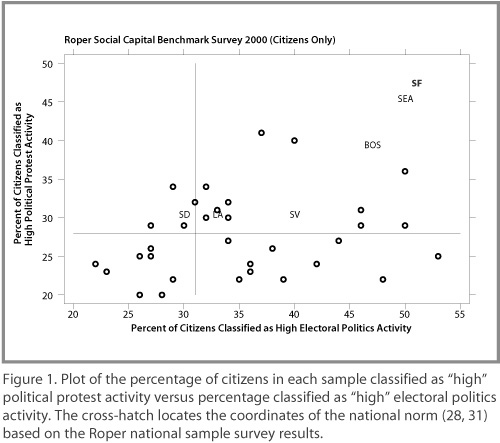
As a quick sidebar, it is worth noting that San Francisco’s non-citizens (52 were included in the sample) were also quite politically active, well-informed, and civically engaged outside the formal context of voting. To illustrate, 18 percent of them knew the names of both U.S. Senators, 29 percent said they were “very interested” in politics and national affairs, 33 percent said they worked on a community project in the past 12 months, and 21 percent were classified as “high” on the PPA Index. These statistics beat those for non-citizens in other community samples by a wide margin and compare favorably with those registered for the national sample of citizens (20 percent, 31 percent, 39 percent, and 28 percent, respectively).
Political Ideology
Figure 2 plots the percentage of non-whites who identified themselves as moderately or very liberal in each of these community samples against the percentage of whites who did so.
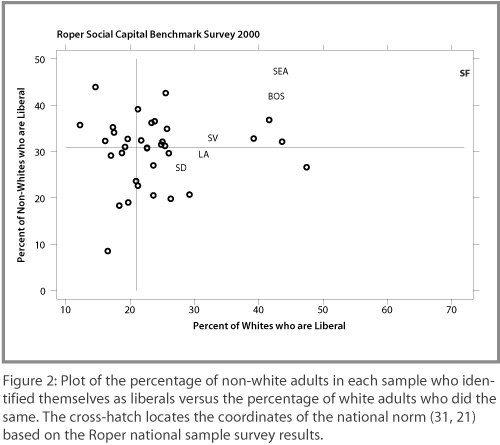
This graph dramatically reveals that San Francisco, ideologically speaking, stands alone and far apart from all the other communities surveyed and from the national norm. None even comes close to matching the estimated 72 percent of San Francisco white respondents who identified themselves as liberals, and only Seattle can rival San Francisco’s estimated 46 percent of non-whites who claimed the same label. San Francisco is indeed an exceedingly liberal city, and its white population is the most liberal of all.
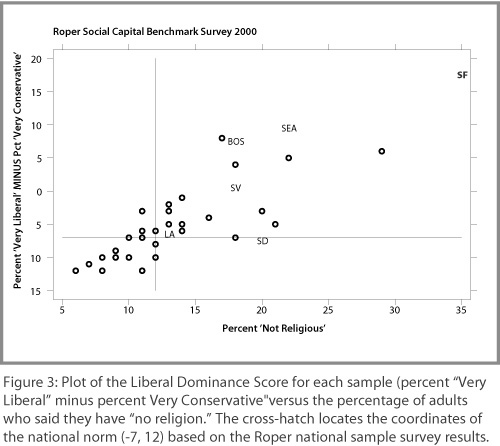
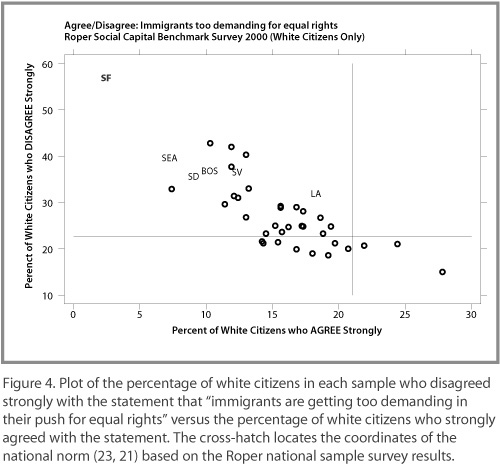
Secularism and Political Ideology
Figure 3 plots the Liberal Dominance Score percent “Very Liberal” minus percent “Very Conservative” in each community sample against the percentage of sample respondents who reported “no religion” when asked about their religious preference.
This graph reveals much that is interesting, most notably that San Francisco is an outlier (extreme case) among the communities surveyed in terms of its secularism (35 percent of the respondents claimed “no religion”) and its liberal dominance vis-à-vis conservatives (+17 percentage points). Further, as clearly shown, there is a strong positive correlation between a community’s level of secularism and its degree of liberal dominance—i.e., the more secular (non-religious), the more liberal. Indeed, secularism is by far the single most powerful predictor of liberalism at the aggregate level of communities—more so than education, income, race, population density, and other community-level variables combined.
As another quick sidebar, it is also worth noting (based on an analysis not shown here) that San Francisco’s high level of secularism is not achieved at the price of an erosion in social capital, as the more general findings of Robert Putnam and his associates might lead one to predict. Nationally and in nearly all community samples, for example, membership in church or synagogue and frequent attendance at religious services are strongly and positively correlated with generalized social trust. The opposite is true for San Francisco, however, where higher rates of membership and attendance are associated with lower levels of social trust—a striking anomaly.
Tolerance: Community Support for Immigrants
San Francisco years ago officially declared itself to be a “city of refuge” and has since enacted a series of “sanctuary city” policies to protect immigrants and refugees. One would expect, therefore, that the Roper survey would show San Franciscans to be especially welcoming and sympathetic toward immigrants. Figure 4, which focuses only on the attitudes of white citizen respondents, offers strong evidence to support that prediction. This graph plots the percentage of white citizens in each sample who disagreed strongly with the statement that “immigrants are getting too demanding in their push for equal rights” against the percentage of white citizens who agreed strongly with it.
Once again, San Francisco stands alone and far apart from all the other communities surveyed and from the national norm. An estimated 56 percent of the city’s white citizen respondents disagreed strongly with the statement, and only 2 percent agreed strongly with it. Nationally and in some other cities, public opinion is sharply polarized on immigration issues. That is not the case in San Francisco, where the popular consensus supporting immigrants is very firm and unified.
Tolerance and Diversity: Personal Friendships with Gays and Lesbians and with Members of Other Racial/Ethnic Groups
Finally, to complete this suite of graphs illuminating the range and variety of local political cultures in the U.S., Figure 5 plots the percentage of respondents in each community sample who reported having a personal friend who is gay orlesbian against the percentage who said they had at least one personal friend in each of the other three major racial/ethnic groups.
As shown in Figure 5, San Francisco and Seattle are at the top of both scales measuring the diversity of personal friendships in community samples. San Francisco edged Seattle in the percentage of respondents who reported having a personal friend who is gay or lesbian (62 percent versus 59 percent), and Seattle slightly edged San Francisco in the percentage claiming personal friendships with members of at least three other racial/ethnic groups (39.3 percent versus 39.0 percent). The Boston and Peninsula/Silicon Valley respondents also reported high levels of diversity in personal friendships on these two scales. Viewing these results, one might object that residents of the low-scoring communities, particularly those with populations that are homogeneously white and straight, have little opportunity where they live to encounter people who are different in those terms and possibly strike up friendships with them. But that kind of objection merely underscores the point that place matters and that certain places, like San Francisco, have more richly diverse social environments than do others.
Summary
Based on the Roper survey evidence, San Francisco indeed lives up to its reputation. It does have a rare and special political culture vis-à-vis the other communities surveyed and national norms. Rivaled only by the residents of Seattle, San Franciscans as a group are the most politically active and civically engaged, the most politically tolerant in their welcoming of immigrants and appreciation of diversity, and by far the most secular and liberal in their political ideology of all the local polities studied here.
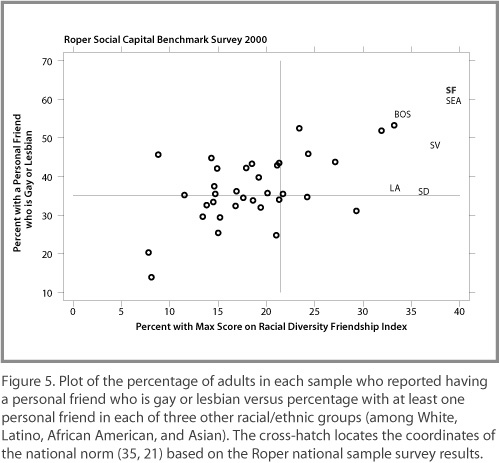
A Concluding Conjecture
Richard Florida’s creative capital theory asserts that “regional economic growth is driven by the location choices of creative people—the holders of creative capital—who prefer places that are diverse, tolerant and open to new ideas” (The Rise of the Creative Class, [Basic Books, 2002], p. 223). The key to understanding the new geography of creativity and its effects on local economic outcomes, he contends, lies in what he calls the “3T’s of economic development: Technology, Talent and Tolerance” (p. 249). His research shows that the San Francisco Bay Area “is the undisputed leader in creativity” and has the greatest long-run potential for economic success of all the large cities and regions he studied.
Based on Florida’s important research and my own analysis of the Roper data, I conjecture that San Francisco has a healthy business climate and a bright future in the emerging new economy because of its highly activist liberal/progressive political culture, not in spite of it. It is San Francisco’s open and tolerant “political climate,” not its nuts and bolts “business climate,” that attracts creative individuals to the city and into its productive workforce. Jobs and capital in the new economy will follow them, not the other way around. Leaders who would organize to rid San Francisco of its “obstructionist” and “anti-business” leftwing crazies, flakes and weirdos thus risk sabotaging the city’s bright economic future by destroying the political culture that secures it. I am aware of the irony of this thesis and am sure that at least some readers of this newsletter may find it surprising and possibly controversial. Nonetheless, it might work better for leaders of capital and community to begin talking with one another in pursuit of mutual accommodation and the public interest rather than continually struggling to bash the other’s brains in. I think SPUR is playing an important role in facilitating this effort, and I hope it continues.
Endnotes:
The data for this article comes from the Roper Social Capital Benchmark Survey, 2000. National sample of 3,003 adults and forty independent community samples with sample sizes ranging from 388 (rural southeast South Dakota) to 1,505 (Peninsula/Silicon Valley). The sample for San Francisco was 500. Method: Telephone surveys. Survey organization: Saguaro Seminar at John F. Kennedy School of Government, Harvard University. TNS Intersearch conducted the interviewing. Field Survey dates: July-November, 2000. Dataset: USMISC2000-SOCCAP. Download data and codebook from: http://www.ropercenter.uconn.edu/scc_bench.html.